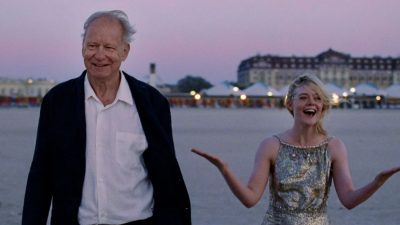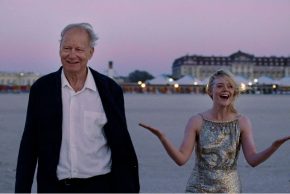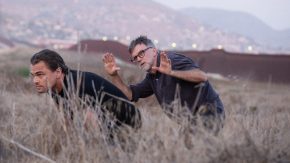First time filmmaker Vasilis Katsoupis launches his movie with an in medias res. Inside opens with the failed attempt of a high scale robbery. Nemo (Willem Dafoe), an artist turned art aficionado slash art thief, gets trapped inside a monochrome art gallery-esque penthouse. Since sheer physical force does not help him in escaping, he must come up with new strategies not only to try and flee, but eventually, to survive.
Katsoupis wrote Inside with Ben Hopkins (Simon Magus) and managed to create a real, moving painting on the big screen. The contemporary art fanatic filmmaker uses Nemo as not only the protagonist of his film, but also as a character living inside a piece of fine art. He is a character in a painting, a sculpture, a source of music as well as the artist behind the piece that is being created. He constructs and deconstructs, embodies and projects all at the same time.
Inside is heavy in symbolism and social criticism. It reflects on art (both maker and subject), plot and plotlessness, first world societies, environmental consciousness, modern day isolation, and our common detachment from reality. Illusions trap us, just like Nemo is trapped on the island of Manhattan.
The Greek newcomer is yet another young filmmaker drawn to such topics as the depreciation of contemporary life, the dangers of modern technology and of influencer culture. Besides Nemo, the only real being is a pigeon outside on the roof. The bird represents authenticity, forgotten simplicity deriving from nature.
Inside also meditates heavily on the role of art, its subject and its place in society. Art is created by its maker. Yet every piece has an ever changing nature, it constantly evolves or decomposes. And more often than not, it keeps on running its course long after its maker is gone. The Greek auteur fills his movie with a number of art references from Duchamp’s famous urinal to the self-portrait of „Dorian Gray”. Right at the beginning of the movie, when Nemo enters the penthouse, we can see a painting very much in the vein of Bosh’s “The Garden of Earthly Delights” suiting the socially critical tone of the movie well.
The absurdness of the instigating incident and the confined space may remind us of works by Buñuel, and the elevated criticism of the elite’s life movies of Sorrentino. The chalkboard drawing Nemo works on resembles the one Gogol’s central character, Poprishchin, creates in the “Diary of a Madman”. These are only a few of the many artistic references, which criss-cross the film like threads in the web of a spider.
The high-end apartment has a coldly minimalist, polish look. That gets sharply juxtaposed with the pureness and liveliness of the vegetation area found in the living room. Nemo is like a worm crawling its way into this strange world. He could be also seen as Robinson Crusoe trying to stay sane on a tropical desert island. This penthouse, even with its distorted and detached form, would be still called home by many. Nemo finds caviar in the fridge, but no drinkable water. Katsoupis asks us bluntly: Do we really have what we need? Or to put it differently, do we really need what we have?

Essentially, Dafoe’s character is on a one-person run struggling with dehydration, low food supply, and extreme weather conditions (the central heating is completely messed up). He is trapped in a dangerously empty and uninhabitable world.
We get to know very little about the backstory and inner world of this man. There is a low emotional attachment we can opt for as audiences, the apartment is bleak in every sense. However, Dafoe’s tour-de-france, predominantly silent, performance fuels his character with desperation and humanity.
Katsoupis uses a number of overhead shots throughout the entire course of the movie. We know from the get-go that we are moving towards the occurrence of something divine, or at least, elevated. As Nemo repeatedly fails to leave the penthouse, he starts building a peculiar construction in the middle of the apartment. He is building his masterpiece, hence one maker is “watching” another
We observe Nemo 24/7, both his struggles and his momentary joys. We are free to judge him if we want to, or merely watch and soak in what he is doing. Nemo is provided with the same choice. He watches the footage of the building’s security cameras. He observes people coming in and out, the staff conducting their daily business. Nemo also embodies the stereotypical middle-aged artist of today. Living like a hermit in a big city studio, stalking on social media, struggling to make ends meet while creating art. He is shrinking into becoming an isolated observer of life.
Aside from the poetic and symbolic strengths of the movie, there is also a thick layer of absurd playfulness to it. Bonus points for the frequent use of “Macarena” by Los Del Río. One of the funniest sequences is when Nemo pretends to record himself, teaching viewers making pasta al dente. What a dig at culinary vloggers. Well, everyone seems to be a chef these days, right?
Dafoe’s Biblical looks fit the story perfectly – no wonder why he had got the part of Jesus in Scorsese’s controversial movie, “The Last Temptation of Christ”. Dafoe fills every scene with sheer truthfulness. He perfectly portrays the decomposing character, going as far as becoming a „shaman” at one point, chanting „I’m dying. I’m dying. I’m dying.”.
Inside is a very promising start for the young Greek filmmaker who combines his knowledge in art with his social awareness effortlessly. It is not only an enjoyable movie, but also a cry for action and for more consciousness.
Not uncommon in feature debuts, Katsoupis is eager to show it all. However, by taming his eagerness and setting his focus on less, he certainly will be a maker of many exciting movies in the future. All in all, this is a thought-provoking, hyper creative and wildly curious movie. Is it smoothly oiled? No, it is not. Is it fascinating and relevant? Yes, it is.
Watch Inside on ROW8M Prime Video, Apple TV, Vudu or Redbox.
~ by Dora Endre ~

























Comments